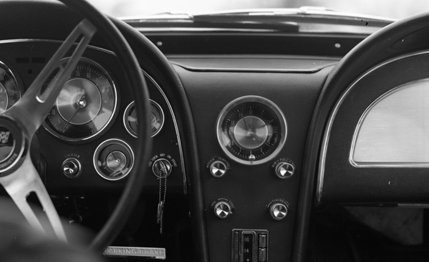The result is a range of adjustment adequate to let our test drivers (ranging in height from five-seven to six-four) find a nearly ideal seating position. Maximum effective leg room (to the accelerator) is 43.7 inches and the maximum vertical height from the seat to the headlining is 33 inches. In view of the over-all height of only 49.8 inches, this is a good example of the care that has gone into designing the living quarters of the new Corvette Sting Ray.
As the engine and drive train are offset one inch to the right to provide wider leg room for the driver, he sits facing exactly in the direction he is going, with the pedals straight in front of him. The accelerator is nicely angled for normally disposed feet, but the clutch pedal has a rather excessive travel. With standard adjustment, you cannot release it without taking your heel off the floor, causing a bit of annoyance in traffic.
Instead of a fly-off handbrake, the Corvette has a T-handle under the instrument panel labeled “Parking Brake” — one of the few features of the new model which reminds you of its relationship with Chevrolet’s mass-produced sedans.
|
|
Compared with previous Corvettes, the Sting Ray is improved in almost every imaginable respect: performance, handling, ride comfort, habitability and trunk space. The trunk is only accessible from inside the car, however, since the tail is full of fuel tank and spare wheel, but the storage space behind the seats is even larger than outside dimensions indicate. A third person, sitting sideways, may come along for short rides, but will soon feel cramped from lack of headroom. An occasional extra passenger will actually be better off sitting on the console between the seats and sharing legroom with the shotgun rider.
Having driven the Corvette Sport Coupé in all kinds of weather conditions, we found the heater and defroster units eminently satisfactory. The heater fan has three speeds, and air entry is variable by a push-pull control. Warm-up is not extremely rapid but seems to be faster than average. The body proved absolutely draft-proof and water-tight.
We liked the ball-shaped interior door handles but were not convinced of the advantages of the wheel-type door lock buttons. A minor complaint is the location of the window winders, as you cannot set your knee against the door panel for bracing on a sharp turn without coming in contact with the window handle.
|
|
Brakes have long been a sore point with Corvettes, and further advance has now been made without taking the full step of going to disc brakes (which the car really deserves). The Delco-Moraine power brakes have 11-inch steel drums cast into the wheel rims, with 58.8% of the braking force being directed to the front wheels. Sintered iron brake linings are optional and will certainly be found necessary for anyone planning to race, as fade is easily provoked with the standard linings, although the cooling-off period required to restore full efficiency is very short.
Chevrolet is prepared for a fair-sized demand for special performance parts, but has restricted their application to the structurally stronger Sport Coupé. The sintered-iron heavy-duty brake system also includes vented backing plates and air scoops and a dual-circuit master cylinder. There is a heavy-duty anti-roll bar, heavy-duty front and rear shock absorbers, aluminum wheels with knock-off hubs, and a 36-gallon fuel tank. The brake mechanism, in contrast to that fitted as standard, automatically adjusts the brakes when applied during forward motion. To be ordered, this special performance kit (RPO ZO6) also requires the 360-bhp engine, the four-speed Warner T-10 gearbox and a Positraction limited-slip differential.
View Photos
View Photos


Leave a Reply